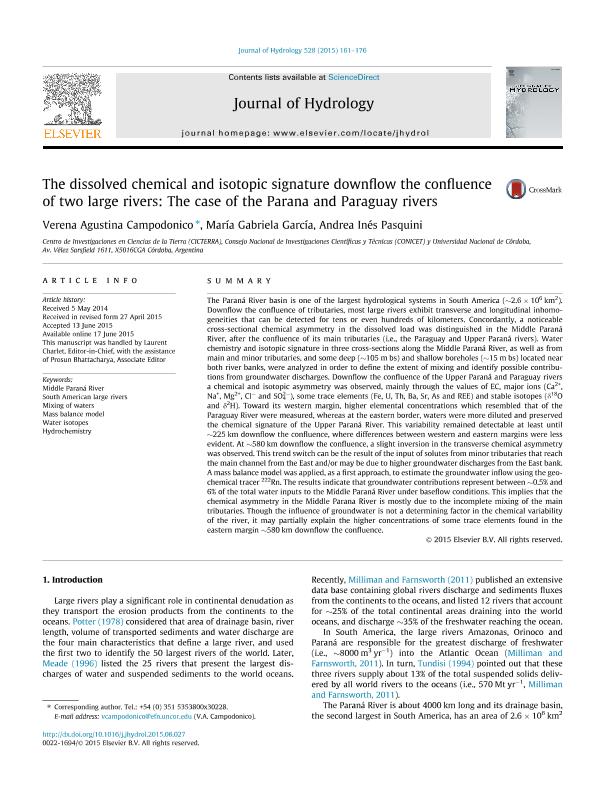Mostrar el registro sencillo del ítem
dc.contributor.author
Campodonico, Verena Agustina

dc.contributor.author
Garcia, Maria Gabriela

dc.contributor.author
Pasquini, Andrea Ines

dc.date.available
2018-04-24T19:41:37Z
dc.date.issued
2015-09
dc.identifier.citation
Campodonico, Verena Agustina; Garcia, Maria Gabriela; Pasquini, Andrea Ines; The dissolved chemical and isotopic signature downflow the confluence of two large rivers: The case of the Parana and Paraguay rivers; Elsevier Science; Journal Of Hydrology; 528; 9-2015; 161-176
dc.identifier.issn
0022-1694
dc.identifier.uri
http://hdl.handle.net/11336/43323
dc.description.abstract
The Paraná River basin is one of the largest hydrological systems in South America (aprox. 2.6 x 106 Km2). Downflow the confluence of tributaries, most large rivers exhibit transverse and Longitudinal inhomogeneities that can be detected for tens or even hundreds of kilometers. Concordantly, a noticeable cross-sectional chemical asymmetry in the dissolved load was distinguished in the Middle Paraná River, after the confluence of its main tributaries (i.e., the Paraguay and Upper Paraná rivers). Water chemistry and isotopic signature in three cross-sections along the Middle Paraná River, as well as from main and minor tributaries, and some deep (105 m bs) and shallow boreholes (15 m bs) located near both river banks, were analyzed in order to define the extent of mixing and identify possible contributions from groundwater discharges. Downflow the confluence of the Upper Paraná and Paraguay rivers a chemical and isotopic asymmetry was observed, mainly through the values of EC, major ions (Ca2+, Na+, Mg2+, Cl- and SO42-), some trace elements (Fe, U, Th, Ba, Sr, As and REE) and stable isotopes (D18O and D2H). Towards its western margin, higher elemental concentrations which resembled that of the Paraguay River were measured, whereas at the eastern border, waters were more diluted and preserved the chemical signature of the Upper Paraná River. This variability remained detectable at least until 225 km downflow the confluence, where differences between western and eastern margins were less evident. At aprox. 580 km downflow the confluence, a slight inversion in the transverse chemical asymmetry was observed. This trend switch can be the result of the input of solutes from minor tributaries that reach the main channel from the East and/or may be due to higher groundwater discharges from the East bank. A mass balance model was applied, as a first approach, to estimate the groundwater inflow using the geochemical tracer 222Rn. The results indicate that groundwater contributions represent between 0.5% and 6% of the total water inputs to the Middle Paraná River under baseflow conditions. This implies that the chemical asymmetry in the Middle Parana River is mostly due to the incomplete mixing of the main tributaries. Though the influence of groundwater is not a determining factor in the chemical variability of the river, it may partially explain the higher concentrations of some trace elements found in the eastern margin aprox. 580 km downflow the confluence.
dc.format
application/pdf
dc.language.iso
eng
dc.publisher
Elsevier Science

dc.rights
info:eu-repo/semantics/openAccess
dc.rights.uri
https://creativecommons.org/licenses/by-nc-sa/2.5/ar/
dc.subject
Middle Parana River
dc.subject
South America Large Rivers
dc.subject
Mixing of Waters
dc.subject
Mass Balance Model
dc.subject.classification
Meteorología y Ciencias Atmosféricas

dc.subject.classification
Ciencias de la Tierra y relacionadas con el Medio Ambiente

dc.subject.classification
CIENCIAS NATURALES Y EXACTAS

dc.subject.classification
Meteorología y Ciencias Atmosféricas

dc.subject.classification
Ciencias de la Tierra y relacionadas con el Medio Ambiente

dc.subject.classification
CIENCIAS NATURALES Y EXACTAS

dc.title
The dissolved chemical and isotopic signature downflow the confluence of two large rivers: The case of the Parana and Paraguay rivers
dc.type
info:eu-repo/semantics/article
dc.type
info:ar-repo/semantics/artículo
dc.type
info:eu-repo/semantics/publishedVersion
dc.date.updated
2018-04-17T16:42:06Z
dc.journal.volume
528
dc.journal.pagination
161-176
dc.journal.pais
Países Bajos

dc.journal.ciudad
Amsterdam
dc.description.fil
Fil: Campodonico, Verena Agustina. Consejo Nacional de Investigaciones Científicas y Técnicas. Centro Científico Tecnológico Conicet - Córdoba. Centro de Investigaciones en Ciencias de la Tierra. Universidad Nacional de Córdoba. Facultad de Ciencias Exactas Físicas y Naturales. Centro de Investigaciones en Ciencias de la Tierra; Argentina
dc.description.fil
Fil: Garcia, Maria Gabriela. Consejo Nacional de Investigaciones Científicas y Técnicas. Centro Científico Tecnológico Conicet - Córdoba. Centro de Investigaciones en Ciencias de la Tierra. Universidad Nacional de Córdoba. Facultad de Ciencias Exactas Físicas y Naturales. Centro de Investigaciones en Ciencias de la Tierra; Argentina
dc.description.fil
Fil: Pasquini, Andrea Ines. Consejo Nacional de Investigaciones Científicas y Técnicas. Centro Científico Tecnológico Conicet - Córdoba. Centro de Investigaciones en Ciencias de la Tierra. Universidad Nacional de Córdoba. Facultad de Ciencias Exactas Físicas y Naturales. Centro de Investigaciones en Ciencias de la Tierra; Argentina
dc.journal.title
Journal Of Hydrology

dc.relation.alternativeid
info:eu-repo/semantics/altIdentifier/url/https://www.sciencedirect.com/science/article/pii/S0022169415004400
dc.relation.alternativeid
info:eu-repo/semantics/altIdentifier/doi/https://doi.org/10.1016/j.jhydrol.2015.06.027
Archivos asociados
